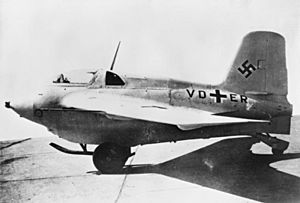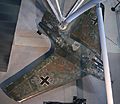Messerschmitt Me 163 facts for kids
Quick facts for kids Messerschmitt Me 163 |
|
|---|---|
 |
|
| Role | Fighter aircraft |
| Manufacturer | Messerschmitt |
| First flight | 1941 |
| Introduction | 1945 |
| Retired | 1945 (Luftwaffe) |
| Primary user | Luftwaffe |
| Number built | 370 |
The Messerschmitt Me 163 was a very special German military aircraft used during World War II. It was unique because it was the first and only rocket-powered aircraft ever used in combat! This amazing plane was so fast and different that it even inspired the Japanese to create their own version, called the Mitsubishi J8M. After the war ended, some of these incredible planes were tested by the Allied forces to learn more about their advanced technology.
Contents
The Rocket Plane: A New Idea
The Messerschmitt Me 163, often called the Komet (which means "Comet" in German), was a truly revolutionary aircraft. Instead of using a propeller engine like most planes at the time, it had a powerful rocket engine. This made it incredibly fast, faster than almost any other plane in the sky during World War II.
How the Rocket Engine Worked
The Me 163 used a special type of rocket engine that burned two different kinds of liquid fuel. When these fuels mixed, they created a huge amount of thrust, pushing the plane forward at amazing speeds. This powerful engine allowed the Komet to climb very quickly and reach high altitudes in just a few minutes.
Fuel and Flight Time
Because the rocket engine used up fuel very quickly, the Me 163 could only fly for a short time, usually just a few minutes. This meant it had to get to its target, attack, and then glide back to the airfield. It was designed for quick, powerful attacks against enemy bombers.
Taking Off and Landing
The Me 163 had a very unusual way of taking off and landing.
The Take-off Dolly
To take off, the Komet didn't have traditional wheels like most planes. Instead, it sat on a special two-wheeled cart called a "dolly." Once the plane reached enough speed and lifted into the air, the pilot would drop this dolly. The dolly would then fall away and be recovered later.
Landing on a Skid
After its short, fast flight, the Me 163 would land on a retractable skid, which was like a long, strong runner underneath the plane. This skid would absorb the shock of landing on the ground. Landing without wheels meant the plane couldn't taxi (move around on the ground) by itself.
The Scheuch-Schlepper Tractor
Once the Komet landed, a special small tractor called a "Scheuch-Schlepper" would come out to meet it. This tractor would lift the plane and tow it back to its hangar or refueling area. This unique system was needed because the plane couldn't move on its own after landing.
The Komet in Action
The Me 163 was mainly used by the Luftwaffe (the German air force) as a fighter plane. Its incredible speed made it very difficult for enemy planes to catch.
Role in World War II
The main job of the Me 163 was to intercept and attack enemy bomber formations. It would zoom up to the bombers, fire its cannons, and then quickly glide away. While it was very fast and a technological marvel, it was built in small numbers (about 370 planes) and had limited impact on the overall outcome of the war.
Testing by Allied Forces
After World War II ended, the Allied forces (like the United States and Great Britain) captured several Me 163s. They were very interested in studying its advanced rocket technology. These captured planes were tested and examined to learn about their design and performance, helping to influence future aircraft development.
Images for kids
-
Me 163B's unsprung jettisonable main gear "dolly" unit
-
Me 163 B-1a at the National Museum of Flight in Scotland
-
A preserved HWK 109-509B "cruiser" twin-chamber rocket motor (National Museum of the United States Air Force)
-
Me 163B, Werknummer 191907, is part of the collection of the Australian War Memorial in Canberra
-
Me 163B, Werknummer 191914, at the Canada Aviation and Space Museum; the tiny propeller operates as a ram air turbine that provided electrical power
-
Me 163B 191 301 at Wright Field display in October 1945
-
Unrestored Messerschmitt Me 163B Komet at the Udvar-Hazy center
-
Me 163B at Wright-Patterson National Air Force Museum
See also
 In Spanish: Messerschmitt Me 163 para niños
In Spanish: Messerschmitt Me 163 para niños



















